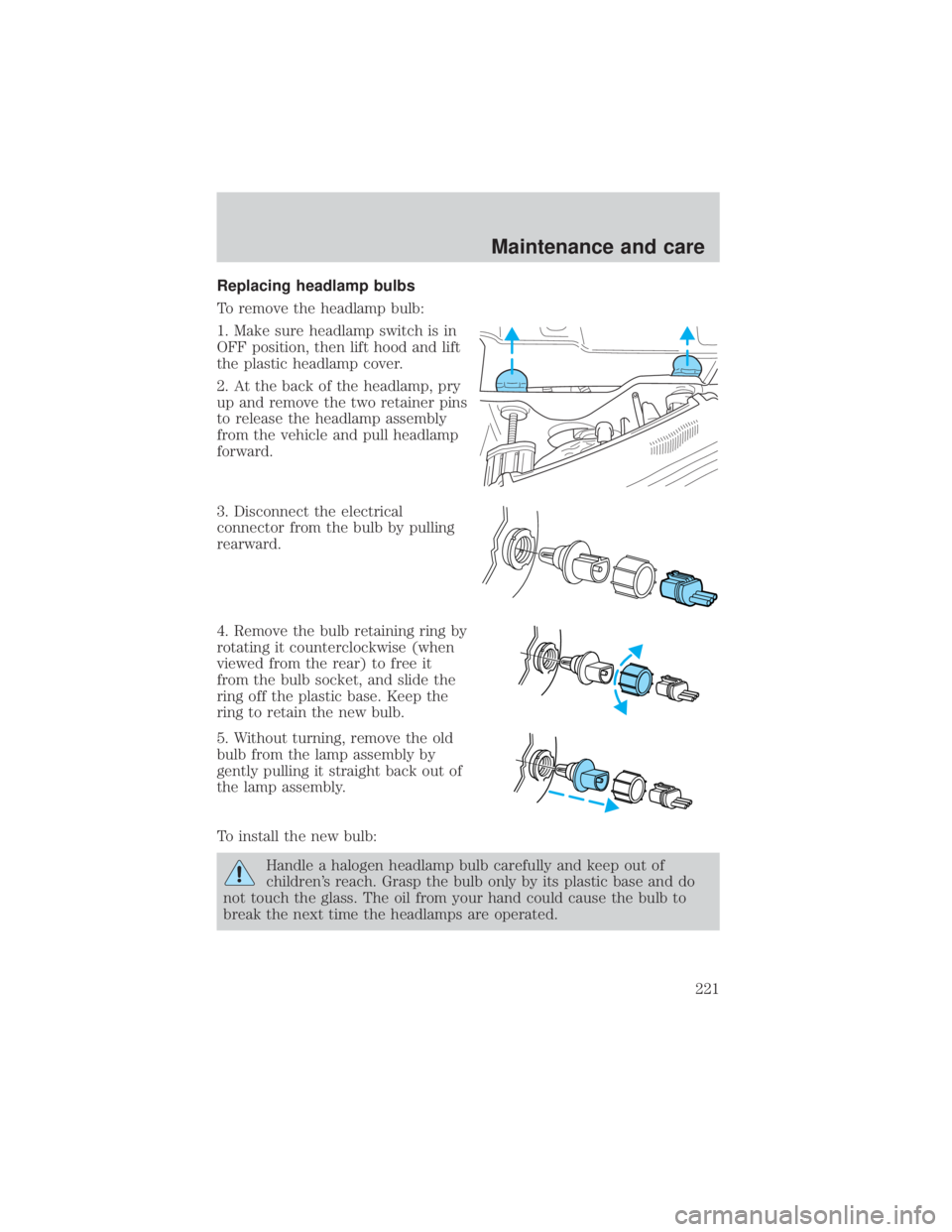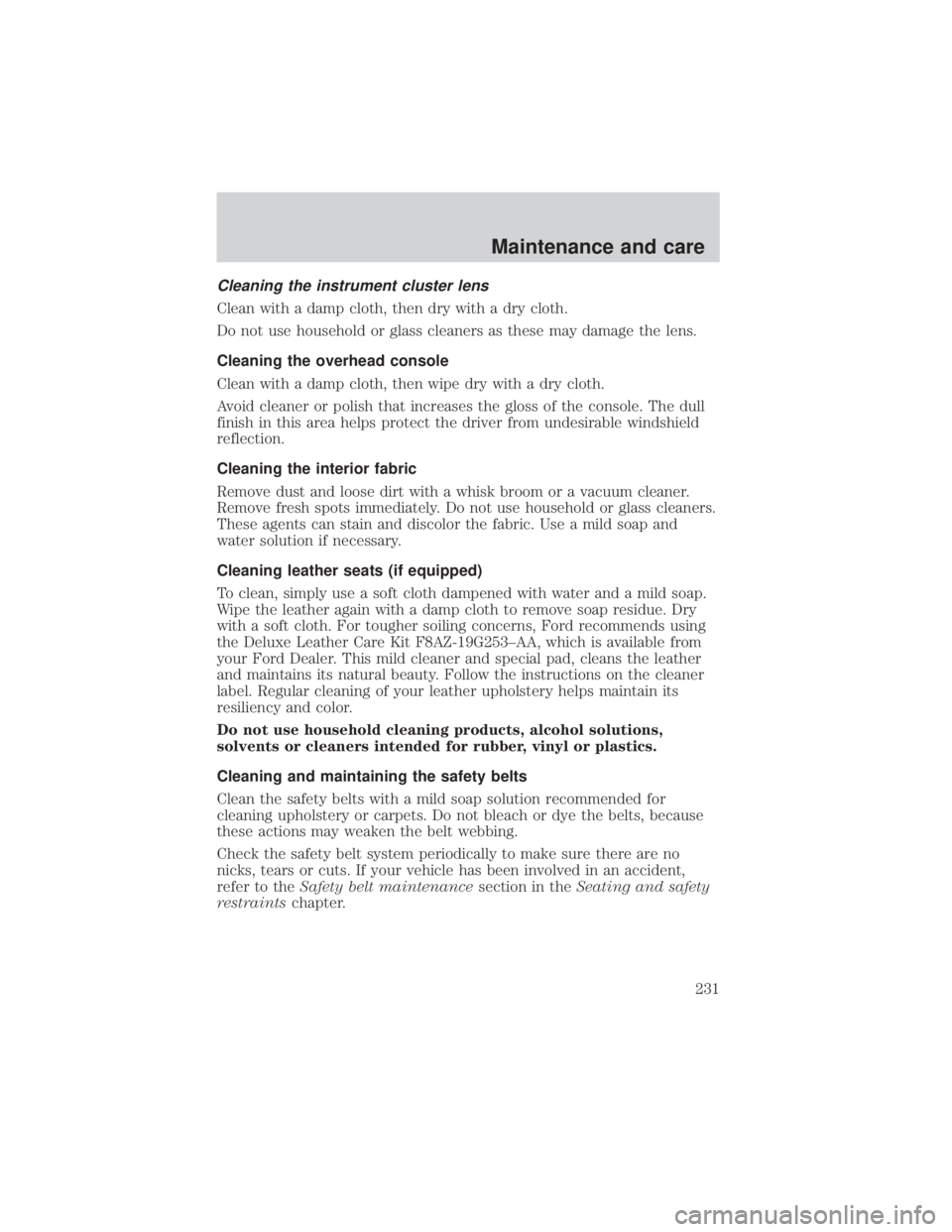2001 FORD EXPLORER SPORT TRAC oil
[x] Cancel search: oilPage 221 of 264

Replacing headlamp bulbs
To remove the headlamp bulb:
1. Make sure headlamp switch is in
OFF position, then lift hood and lift
the plastic headlamp cover.
2. At the back of the headlamp, pry
up and remove the two retainer pins
to release the headlamp assembly
from the vehicle and pull headlamp
forward.
3. Disconnect the electrical
connector from the bulb by pulling
rearward.
4. Remove the bulb retaining ring by
rotating it counterclockwise (when
viewed from the rear) to free it
from the bulb socket, and slide the
ring off the plastic base. Keep the
ring to retain the new bulb.
5. Without turning, remove the old
bulb from the lamp assembly by
gently pulling it straight back out of
the lamp assembly.
To install the new bulb:
Handle a halogen headlamp bulb carefully and keep out of
children's reach. Grasp the bulb only by its plastic base and do
not touch the glass. The oil from your hand could cause the bulb to
break the next time the headlamps are operated.
Maintenance and care
221
Page 230 of 264

Cleaning non-painted plastic exterior parts
Use vinyl cleaner for routine cleaning. Clean with a tar remover if
necessary. Do not clean plastic parts with thinners, solvents or
petroleum-based cleaners.
Cleaning the exterior lamps
Wash with the same detergent as the exterior of your vehicle. If
necessary, use a tar remover such as Ford Extra Strength Tar and Road
Oil Remover (B7A-19520±AA).
To avoid scratching the lamps, do not use a dry paper towel, chemical
solvents or abrasive cleaners.
Cleaning the windshield, wiper blades and rear window
If the wiper blades do not wipe properly, clean the wiper blade rubber
element with undiluted windshield washer solution or a mild detergent.
To avoid damaging the blades, do not use fuel, kerosene, paint thinner or
other solvents.
If the wiper still does not wipe properly, this could be caused by
substances on the windshield or rear window such as tree sap and some
hot wax treatments used by commercial car washes. Clean the outside of
the windshield or rear window with a non-abrasive cleaner such as Ford
Ultra-Clear Spray Glass Cleaner, (E4AZ-19C507±AA), available from your
Ford Dealer.Do notuse abrasive cleansers on glass as they may cause
scratches. The windshield or rear window is clean if beads do not form
when you rinse it with water. The windshield, rear window and wiper
blades should be cleaned on a regular basis, and blades or rubber
elements replaced when worn.
Cleaning the instrument panel
Clean with a damp cloth, then dry with a dry cloth.
Avoid cleaner or polish that increases the gloss of the upper portion of
the instrument panel. The dull finish in this area helps protect the driver
from undesirable windshield reflection.
Do not use chemical solvents or strong detergents when cleaning
the steering wheel or instrument panel to avoid contamination of
the air bag system.
Maintenance and care
230
Page 231 of 264

Cleaning the instrument cluster lens
Clean with a damp cloth, then dry with a dry cloth.
Do not use household or glass cleaners as these may damage the lens.
Cleaning the overhead console
Clean with a damp cloth, then wipe dry with a dry cloth.
Avoid cleaner or polish that increases the gloss of the console. The dull
finish in this area helps protect the driver from undesirable windshield
reflection.
Cleaning the interior fabric
Remove dust and loose dirt with a whisk broom or a vacuum cleaner.
Remove fresh spots immediately. Do not use household or glass cleaners.
These agents can stain and discolor the fabric. Use a mild soap and
water solution if necessary.
Cleaning leather seats (if equipped)
To clean, simply use a soft cloth dampened with water and a mild soap.
Wipe the leather again with a damp cloth to remove soap residue. Dry
with a soft cloth. For tougher soiling concerns, Ford recommends using
the Deluxe Leather Care Kit F8AZ-19G253±AA, which is available from
your Ford Dealer. This mild cleaner and special pad, cleans the leather
and maintains its natural beauty. Follow the instructions on the cleaner
label. Regular cleaning of your leather upholstery helps maintain its
resiliency and color.
Do not use household cleaning products, alcohol solutions,
solvents or cleaners intended for rubber, vinyl or plastics.
Cleaning and maintaining the safety belts
Clean the safety belts with a mild soap solution recommended for
cleaning upholstery or carpets. Do not bleach or dye the belts, because
these actions may weaken the belt webbing.
Check the safety belt system periodically to make sure there are no
nicks, tears or cuts. If your vehicle has been involved in an accident,
refer to theSafety belt maintenancesection in theSeating and safety
restraintschapter.
Maintenance and care
231
Page 233 of 264

MOTORCRAFT PART NUMBERS
Component 4.0L SOHC V6 engine
Air filter element FA-1658
Fuel filter FG-986B
Battery BXT-65-650
Oil filter FL-820S
PCV valve EV-243
Spark plugs* AGSF-22PP
* Refer to Vehicle Emissions Control Information (VECI) decal for spark
plug gap information.
REFILL CAPACITIES
Fluid Ford Part
NameApplication
Capacity
Brake and
clutch fluidHigh
Performance
DOT 3 Motor
Vehicle Brake
FluidAll Fill to line on
reservoir
Engine oil
(including filter
change)Motorcraft SAE
5W-30 Super
Premium Motor
OilAll 4.7L (5.0
quarts)
Fuel tank N/A All 77.6L (20.5
gallons)
Power steering
fluidMotorcraft
MERCONtAT FAll Fill to line on
reservoir
Transmission
fluid
1Motorcraft
MERCONtV
AT F5R55E
Automatic (4x2)9.5L (10.0
quarts)2
5R55E
Automatic (4x4)9.8L (10.3
quarts)2
Transfer case Motorcraft
MERCONtAT F4WD 1.2L (1.3
quarts)3
Capacities and specifications
233
Page 236 of 264

ItemFord Part
Name or
equivalentFord Part
NumberFord
Specification
Engine coolant Motorcraft
Premium Engine
Coolant
(green-colored)VC-4±A (US) or
CXC-10
(Canada)ESE-M97B44-A
Motorcraft
Premium Gold
Engine Coolant
(yellow-colored)VC-7±A WSS-M97B51-A1
Engine oilMotorcraft SAE
5W-30 Super
Premium Motor
OilXO-5W30-QSPWSS-M2C153-G
with API
Certification
Mark
Automatic
transmission
(5R55E)
1
Motorcraft
MERCONtV
AT FXT-5-QM MERCONtV
Power steering
fluidMotorcraft
MERCON
Multi-Purposet
AT FXT-2-QDX MERCONt
Ford
conventional and
Traction-Lok
rear axles
2, 3, 4 2, 3, 4 2, 3, 4
Front axle
(4X4)Motorcraft SAE
80W-90
Premium Rear
Axle LubricantXY-80W90-QL WSP-M2C197-A
Transfer case
(4X4)Motorcraft
MERCON
Multi-Purposet
AT FXT-2-QDX MERCONt
Capacities and specifications
236
Page 250 of 264

Protection and appearance equipment
Air bag anti-theft locks
Automatic headlamp system
Bed mats
Berber floor mats
Carpet floor mats
Cleaners, waxes and polishes
Door edge guards
Front end covers (full and mini)
Hood deflectors
Locking gas cap
Lubricants and oils
Molded splash guards
Molded vinyl floor mats
Rear window deflectors
Side window air deflectors
Skid plate kit
Spare tire lock
Tonneau covers (hard)
Touch-up paint
Truck covers
For maximum vehicle performance, keep the following information in
mind when adding accessories or equipment to your vehicle:
²When adding accessories, equipment, passengers and luggage to your
vehicle, do not exceed the total weight capacity of the vehicle or of
the front or rear axle (GVWR or GAWR as indicated on the Safety
compliance certification label). Consult your dealer for specific weight
information.
²
The Federal Communications Commission (FCC) and Canadian Radio
Telecommunications Commission (CRTC) regulate the use of mobile
communications systems - such as two-way radios, telephones and theft
alarms - that are equipped with radio transmitters. Any such equipment
installed in your vehicle should comply with FCC or CRTC regulations
and should be installed only by a qualified service technician.
Customer assistance
250
Page 255 of 264

instrument cluster lens ..........231
instrument panel ....................230
interior .....................................231
mirrors .....................................232
plastic parts ............................230
safety belts ..............................231
washing ....................................227
waxing .....................................228
wheels ......................................229
windows ..................................232
wiper blades ............................230
Climate control (see Air
conditioning or Heating) ............20
Clock ......................................35, 50
Clutch
fluid ..........................................189
operation while driving ..........140
recommended shift speeds ....141
Compass, electronic ....................65
calibration .................................67
set zone adjustment .................66
Console ........................................72
overhead ....................................63
Controls
power seat .................................98
Coolant
checking and adding ..............191
refill capacities ................195, 233
specifications ..................235, 238
Cruise control (see Speed
control) ........................................56
Customer Assistance ................158
Ford accessories for your
vehicle .....................................249
Ford Extended Service
Plan ..........................................241
Getting assistance outside the
U.S. and Canada .....................247Getting roadside assistance ...158
Getting the service
you need .................................241
Ordering additional owner's
literature .................................251
The Dispute Settlement
Board .......................................243
Utilizing the
Mediation/Arbitration
Program ...................................247
D
Daytime running lamps
(see Lamps) ................................18
Dipstick
automatic transmission
fluid ..........................................196
engine oil .................................185
Doors
door ajar warning .....................12
lubricant specifications ..........235
Driving under special
conditions ..........................146±147
mud ..........................................146
sand .........................................146
snow and ice ...........................147
through water .................146, 150
E
Emergencies, roadside
jump-starting ..........................174
Emission control system ..........218
Engine ........................................238
check engine/service engine
soon light ....................................8
cleaning ...................................229
coolant .....................................191
idle speed control ...................200
Index
255
Page 256 of 264

lubrication
specifications ..................235, 238
refill capacities ........................233
service points ..........................184
starting after a collision .........159
Engine block heater .................130
Engine oil ..................................185
checking and adding ..............185
dipstick ....................................185
filter, specifications ........187, 233
recommendations ...................187
refill capacities ........................233
specifications ..................235, 238
Exhaust fumes ..........................131
F
Flexible Fuel Vehicle (FFV) ....208
Floor mats ...................................74
Fluid capacities .........................233
Foglamps .....................................18
Four-Wheel Drive
vehicles ................................12, 142
control trac ...............................27
description ..............................143
driving off road .......................145
electronic shift ..................27, 143
indicator light .........................143
preparing to drive your
vehicle .....................................135
Fuel ............................................208
calculating fuel economy .......215
cap .......................................9, 214
capacity ...................................233
choosing the right fuel ...........211
comparisons with EPA fuel
economy estimates .................218
detergent in fuel .....................213filling your vehicle
with fuel ..................208, 214±215
filter, specifications ........215, 233
fuel pump shut-off switch .....159
gauge .........................................17
improving fuel economy ........215
octane rating ...................211, 238
quality ......................................212
running out of fuel .................213
safety information relating to
automotive fuels .....................208
Fuses ..................................161±162
G
Garage door opener ....................63
Gas cap (see Fuel cap) ........9, 214
Gas mileage (see Fuel
economy) ...................................215
Gauges .........................................14
battery voltage gauge ...............16
engine coolant temperature
gauge .........................................15
engine oil pressure gauge ........16
fuel gauge ..................................17
odometer ...................................15
speedometer .............................14
tachometer ................................16
trip odometer ............................15
GAWR (Gross Axle Weight
Rating) .......................................148
calculating ...............................150
definition .................................148
driving with a heavy load ......148
location ....................................148
GVWR (Gross Vehicle Weight
Rating) .......................................148
calculating .......................148, 150
definition .................................148
Index
256